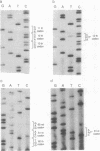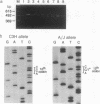Abstract
A mouse strain with low lung tumor susceptibility (C3H) and a strain with high lung tumor susceptibility (A/J) were reciprocally crossed to produce C3A and AC3 F1 hybrid mice. Ki-ras oncogenes were detected in spontaneous and chemically induced lung tumors obtained from the C3A and AC3 mice. To further explore the genetics of the Ki-ras gene in mouse lung tumor susceptibility, the parental origin of Ki-ras oncogenes detected in lung tumors from the F1 hybrids was determined by a strategy based on a 37-base-pair deletion in the second intron of the A/J Ki-ras allele. Ki-ras oncogenes were derived from the A/J parent in 38 of 40 tumors obtained from C3A mice and 30 of 30 tumors from AC3 mice. The observation that the activated oncogene in hybrids originates from the susceptible parent suggests that the Ki-ras gene is directly linked to mouse lung tumor susceptibility. This finding may have implications for pulmonary adenocarcinoma development in humans, since Ki-ras oncogenes are detected in 35% of this human tumor type.
Full text
PDF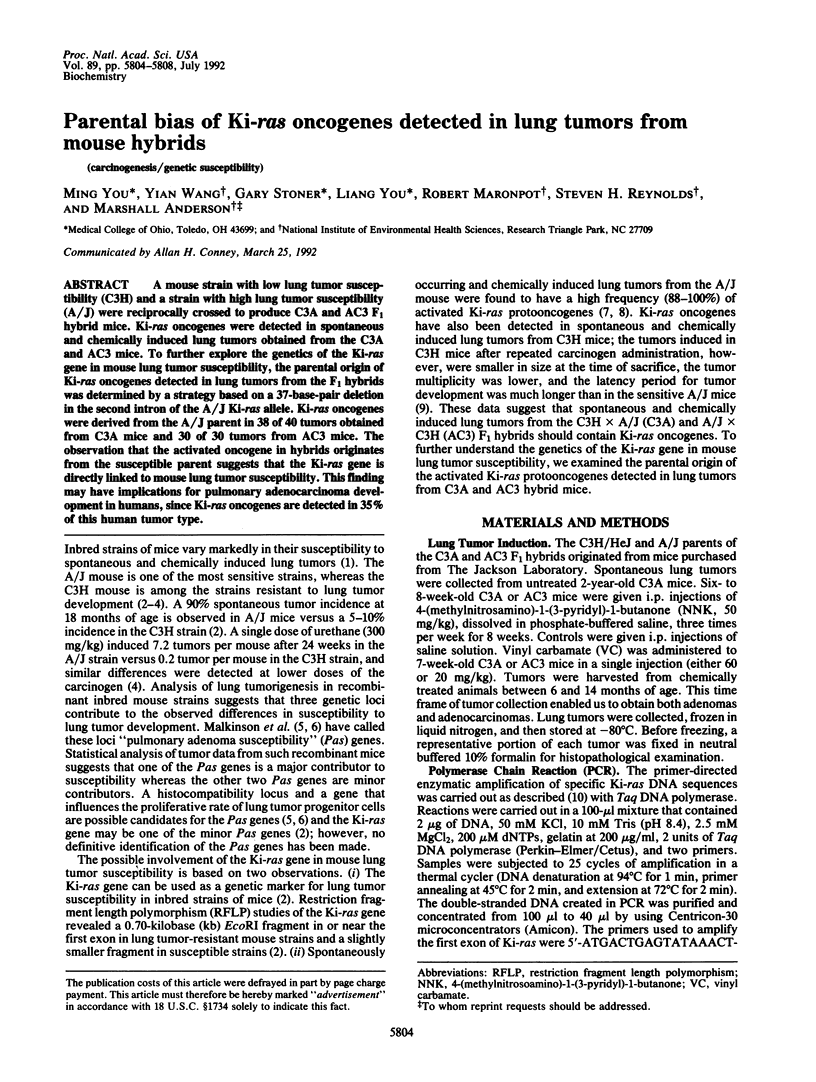
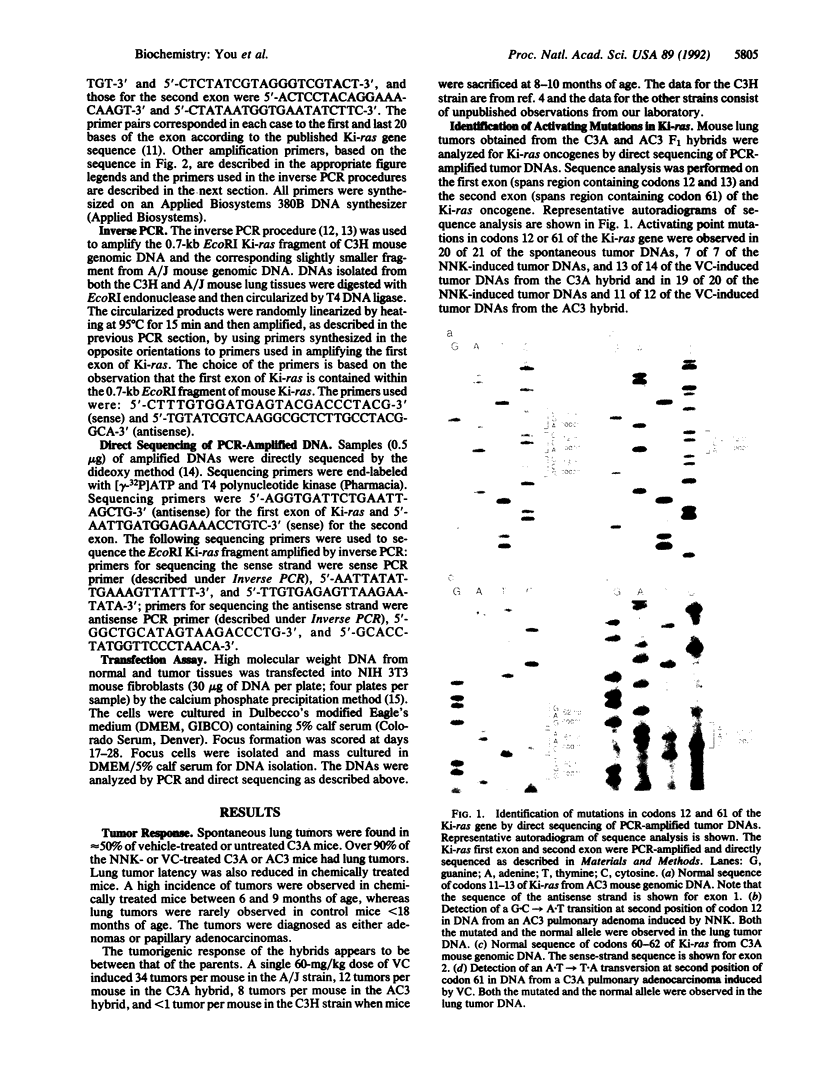
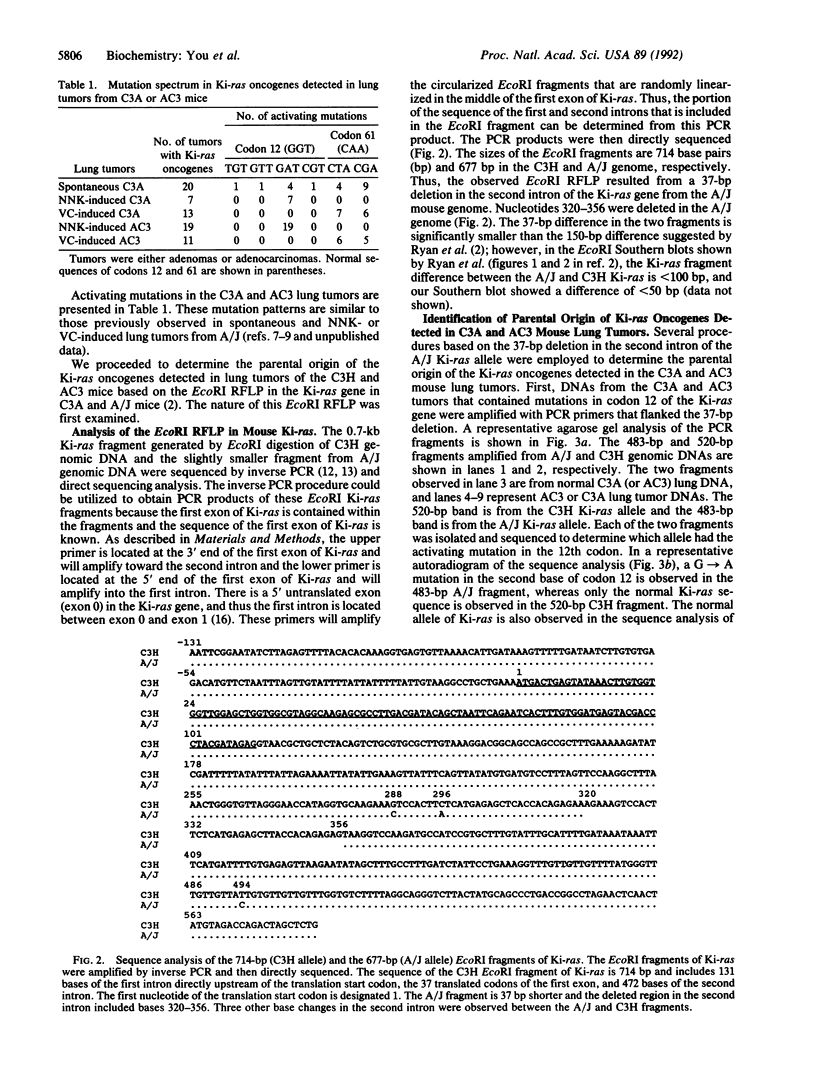
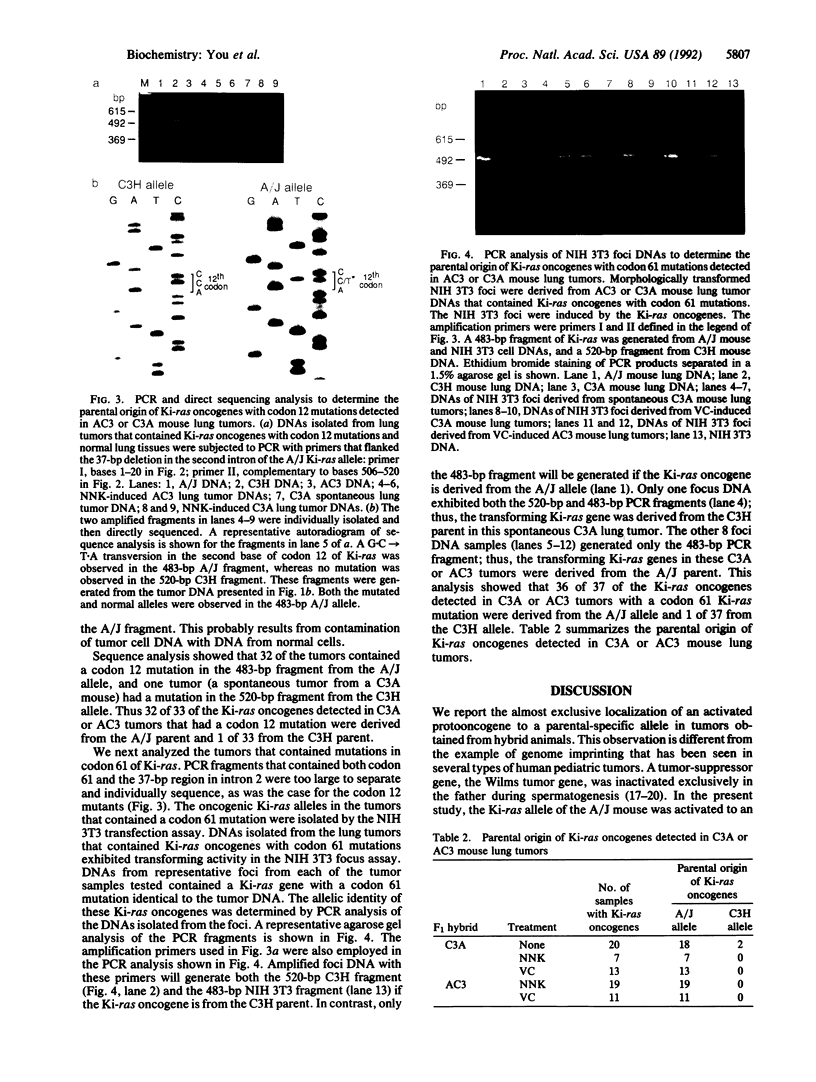

Images in this article
Selected References
These references are in PubMed. This may not be the complete list of references from this article.
- Allen J. W., Stoner G. D., Pereira M. A., Backer L. C., Sharief Y., Hatch G. G., Campbell J. A., Stead A. G., Nesnow S. Tumorigenesis and genotoxicity of ethyl carbamate and vinyl carbamate in rodent cells. Cancer Res. 1986 Oct;46(10):4911–4915. [PubMed] [Google Scholar]
- Barbacid M. ras genes. Annu Rev Biochem. 1987;56:779–827. doi: 10.1146/annurev.bi.56.070187.004023. [DOI] [PubMed] [Google Scholar]
- Belinsky S. A., Devereux T. R., Maronpot R. R., Stoner G. D., Anderson M. W. Relationship between the formation of promutagenic adducts and the activation of the K-ras protooncogene in lung tumors from A/J mice treated with nitrosamines. Cancer Res. 1989 Oct 1;49(19):5305–5311. [PubMed] [Google Scholar]
- Bos J. L. ras oncogenes in human cancer: a review. Cancer Res. 1989 Sep 1;49(17):4682–4689. [PubMed] [Google Scholar]
- Devereux T. R., Anderson M. W., Belinsky S. A. Role of ras protooncogene activation in the formation of spontaneous and nitrosamine-induced lung tumors in the resistant C3H mouse. Carcinogenesis. 1991 Feb;12(2):299–303. doi: 10.1093/carcin/12.2.299. [DOI] [PubMed] [Google Scholar]
- George D. L., Scott A. F., Trusko S., Glick B., Ford E., Dorney D. J. Structure and expression of amplified cKi-ras gene sequences in Y1 mouse adrenal tumor cells. EMBO J. 1985 May;4(5):1199–1203. doi: 10.1002/j.1460-2075.1985.tb03760.x. [DOI] [PMC free article] [PubMed] [Google Scholar]
- Hoffman E. K., Trusko S. P., Freeman N., George D. L. Structural and functional characterization of the promoter region of the mouse c-Ki-ras gene. Mol Cell Biol. 1987 Jul;7(7):2592–2596. doi: 10.1128/mcb.7.7.2592. [DOI] [PMC free article] [PubMed] [Google Scholar]
- Hoffman E. K., Trusko S. P., Murphy M., George D. L. An S1 nuclease-sensitive homopurine/homopyrimidine domain in the c-Ki-ras promoter interacts with a nuclear factor. Proc Natl Acad Sci U S A. 1990 Apr;87(7):2705–2709. doi: 10.1073/pnas.87.7.2705. [DOI] [PMC free article] [PubMed] [Google Scholar]
- Malkinson A. M., Beer D. S. Major effect on susceptibility to urethan-induced pulmonary adenoma by a single gene in BALB/cBy mice. J Natl Cancer Inst. 1983 May;70(5):931–936. [PubMed] [Google Scholar]
- Malkinson A. M., Nesbitt M. N., Skamene E. Susceptibility to urethan-induced pulmonary adenomas between A/J and C57BL/6J mice: use of AXB and BXA recombinant inbred lines indicating a three-locus genetic model. J Natl Cancer Inst. 1985 Nov;75(5):971–974. doi: 10.1093/jnci/75.5.971. [DOI] [PubMed] [Google Scholar]
- Malkinson A. M. The genetic basis of susceptibility to lung tumors in mice. Toxicology. 1989 Mar;54(3):241–271. doi: 10.1016/0300-483x(89)90062-0. [DOI] [PubMed] [Google Scholar]
- Ochman H., Gerber A. S., Hartl D. L. Genetic applications of an inverse polymerase chain reaction. Genetics. 1988 Nov;120(3):621–623. doi: 10.1093/genetics/120.3.621. [DOI] [PMC free article] [PubMed] [Google Scholar]
- Orita M., Sekiya T., Hayashi K. DNA sequence polymorphisms in Alu repeats. Genomics. 1990 Oct;8(2):271–278. doi: 10.1016/0888-7543(90)90282-y. [DOI] [PubMed] [Google Scholar]
- Reynolds S. H., Anna C. K., Brown K. C., Wiest J. S., Beattie E. J., Pero R. W., Iglehart J. D., Anderson M. W. Activated protooncogenes in human lung tumors from smokers. Proc Natl Acad Sci U S A. 1991 Feb 15;88(4):1085–1089. doi: 10.1073/pnas.88.4.1085. [DOI] [PMC free article] [PubMed] [Google Scholar]
- Reynolds S. H., Stowers S. J., Maronpot R. R., Anderson M. W., Aaronson S. A. Detection and identification of activated oncogenes in spontaneously occurring benign and malignant hepatocellular tumors of the B6C3F1 mouse. Proc Natl Acad Sci U S A. 1986 Jan;83(1):33–37. doi: 10.1073/pnas.83.1.33. [DOI] [PMC free article] [PubMed] [Google Scholar]
- Rodenhuis S., Slebos R. J., Boot A. J., Evers S. G., Mooi W. J., Wagenaar S. S., van Bodegom P. C., Bos J. L. Incidence and possible clinical significance of K-ras oncogene activation in adenocarcinoma of the human lung. Cancer Res. 1988 Oct 15;48(20):5738–5741. [PubMed] [Google Scholar]
- Ryan J., Barker P. E., Nesbitt M. N., Ruddle F. H. KRAS2 as a genetic marker for lung tumor susceptibility in inbred mice. J Natl Cancer Inst. 1987 Dec;79(6):1351–1357. [PubMed] [Google Scholar]
- Saiki R. K., Gelfand D. H., Stoffel S., Scharf S. J., Higuchi R., Horn G. T., Mullis K. B., Erlich H. A. Primer-directed enzymatic amplification of DNA with a thermostable DNA polymerase. Science. 1988 Jan 29;239(4839):487–491. doi: 10.1126/science.2448875. [DOI] [PubMed] [Google Scholar]
- Sapienza C. Genome imprinting, cellular mosaicism and carcinogenesis. Mol Carcinog. 1990;3(3):118–121. doi: 10.1002/mc.2940030303. [DOI] [PubMed] [Google Scholar]
- Schroeder W. T., Chao L. Y., Dao D. D., Strong L. C., Pathak S., Riccardi V., Lewis W. H., Saunders G. F. Nonrandom loss of maternal chromosome 11 alleles in Wilms tumors. Am J Hum Genet. 1987 May;40(5):413–420. [PMC free article] [PubMed] [Google Scholar]
- Scrable H. J., Sapienza C., Cavenee W. K. Genetic and epigenetic losses of heterozygosity in cancer predisposition and progression. Adv Cancer Res. 1990;54:25–62. doi: 10.1016/s0065-230x(08)60807-6. [DOI] [PubMed] [Google Scholar]
- Shimkin M. B., Stoner G. D. Lung tumors in mice: application to carcinogenesis bioassay. Adv Cancer Res. 1975;21:1–58. doi: 10.1016/s0065-230x(08)60970-7. [DOI] [PubMed] [Google Scholar]
- Tindall K. R., Stankowski L. F., Jr Molecular analysis of spontaneous mutations at the gpt locus in Chinese hamster ovary (AS52) cells. Mutat Res. 1989 Mar-May;220(2-3):241–253. doi: 10.1016/0165-1110(89)90028-6. [DOI] [PubMed] [Google Scholar]
- Toguchida J., Ishizaki K., Sasaki M. S., Nakamura Y., Ikenaga M., Kato M., Sugimot M., Kotoura Y., Yamamuro T. Preferential mutation of paternally derived RB gene as the initial event in sporadic osteosarcoma. Nature. 1989 Mar 9;338(6211):156–158. doi: 10.1038/338156a0. [DOI] [PubMed] [Google Scholar]
- Triglia T., Peterson M. G., Kemp D. J. A procedure for in vitro amplification of DNA segments that lie outside the boundaries of known sequences. Nucleic Acids Res. 1988 Aug 25;16(16):8186–8186. doi: 10.1093/nar/16.16.8186. [DOI] [PMC free article] [PubMed] [Google Scholar]
- You M., Candrian U., Maronpot R. R., Stoner G. D., Anderson M. W. Activation of the Ki-ras protooncogene in spontaneously occurring and chemically induced lung tumors of the strain A mouse. Proc Natl Acad Sci U S A. 1989 May;86(9):3070–3074. doi: 10.1073/pnas.86.9.3070. [DOI] [PMC free article] [PubMed] [Google Scholar]



